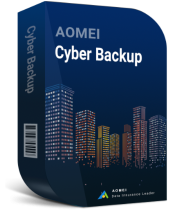What Is Granular Recovery Technology and How It Works
When your server goes down and you need to urgently recover data from the backups, you certainly want the business downtime to be as short as possible. And if possible, prioritize the recovery of critical files, and then work on the rest gradually. Granular recovery technology (GRT) can help you with this.
What is granular recovery technology
Granular recovery is a technology that allows recovery of individual or partial items from backup sets. For example, recovering specific files or folders from a complete image-level virtual machine backup, instead of the entire VM.
Granular recovery technology (GRT) provides an innovative solution to IT administrators’ need of recovering data faster and with greater granularity. By reducing recovery time, GRT simplifies disaster recovery and effectively maintains business continuity.
Applications support granular recovery technology (GRT)
Granular recovery technology is widely used in both physical and virtual environments, typically with the following applications:
- Microsoft Active Directory
- Microsoft Exchange
- Microsoft SharePoint
- Microsoft Hyper-V
- VMware ESXi
How does granular recovery technology work
The granular recovery technology bases mainly on one of the two methods:
Object recovery: This method is good for built-in backup solutions, operating with an internal structure or a list of objects used by some software. The pros of this method are obvious sorting criteria for restoration; the cons mainly are the time to recovery and inflexibility.
File or folder recovery: This is a “generic” method, recovering a file, folder, website or SQL table by its name and/or attributes. It is fast and reliable, if you can manage your restoration content by filenames (such as time stamps). This method is great for external backup solutions.
Traditional recovery vs granular recovery: What’s the difference?
With the advent of granular recovery technology, it is true that the popularity of traditional recovery has more or less declined. However, many companies still refuse to abandon traditional recovery. So why can’t they completely replace each other? What are the differences between traditional recovery and granular recovery?
In terms of the recovery process, for example, to recover a single file from an image-level VM backup. In traditional recovery ways, you will need to first restore the entire virtual machine and then find the specific file. However, in granular recovery technology, you can just open this backup and recover only the file you need from it.
Their differences can be summarized into 3 points:
- Efficiency: Granular recovery technology brings higher efficiency, especially when you are asked to recover only the specific files, it saves time in recovering other unnecessary data.
- Difficulty: The traditional full backup recovery is a very simple process that can be achieved in just a few steps. Granular recovery, on the other hand, being an innovative new technology, employees may need to be trained to operate it freely.
- Cost: While the cost of traditional recovery is mainly in recovery time and storage space, the granular recovery technology itself provided by third-party software require costs. For organizations that cannot completely abandon traditional full backup and recovery, this can be an additional expense.
How to choose between traditional and granular recovery
Although granular recovery technology can bring greater efficiency in times of emergency, traditional full backup and recovery is still one of the most common requirements. Therefore, it is not recommended to completely replace traditional recovery with granular recovery.
Granular recovery technology can be a real savior if you have urgent needs to recover specific files from a full backup and long recovery time can cause great loss. However, the ability of traditional recovery to retrieve the entire backup at once cannot be replaced by granular recovery.
For organizations that are expanding their business, or need to migrate a large number of workloads, traditional full backup and recovery is clearly more efficient.
As a result, most enterprises cannot afford to abandon traditional full backup and restore while pursuing the efficiency of granular recovery. However, this may further increase the cost spent on data protection.
Ideal choice for your data backup and recovery
AOMEI Cyber Backup is an all-in-one backup software designed to secure your data and ensure uninterrupted access to critical resources. Built for businesses of all sizes, it provides comprehensive data protection for both physical and virtual environments, including support for VMware and Hyper-V.
- Free VMware & Hyper-V VMs protection.
- Automatic backup VMs/ SQL Servers/ Physical Servers.
- Fast data recovery with minimal downtime.
Summary
For enterprises, less business downtime means less wasted costs. When you have a need to recover specific files from a full backup and long recovery time can cause great loss, perhaps granular recovery technology is what you need.
In this article, I introduced what is granular recovery technology (GRT), and compares it to traditional recovery. Although granular recovery technology still cannot completely replace traditional full backup and recovery, but it may be very helpful when you have an emergency.






